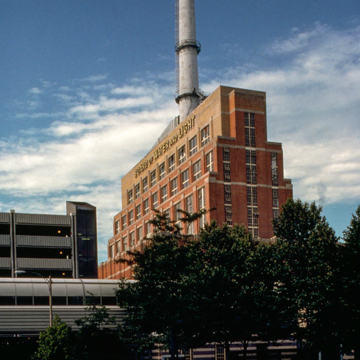You are here
Accident Fund Insurance Company of America World Headquarters (Lansing Board of Water and Light, Ottawa Street Power Station)
This office building, formerly the Ottawa Street Power Station, is an architectural surprise in Art Deco. The now decommissioned plant was designed by Bowd-Munson Company of Lansing for the Lansing Board of Water and Light, which generated electricity and steam here on the site of the earlier downtown steam and electric plant. The earlier plant was built in 1908 by the Michigan Power Company. This work approaches Public Works Administration (PWA) Moderne in style in its classical and formal character combined with the angularity of Art Deco. Symbolizing the combustion of coal, the polished black granite base of the sixteen-story, setback brick structure changes to purple-gray and progressively lighter shades of red, orange, yellow, and yellowish-gray brick as the building rises. Doors of polished metal and glass highlight the main entrance.
In 2007, Accident Fund Insurance Company of America bought and began planning the rehabilitation of the 185,000-square-foot building as part of its world headquarters. A new building with a four-story atrium to the north connects to the historic building and a parking structure at Ottawa Street and Grand Avenue. This civic development project links with a 1,000-foot-long riverfront promenade from the Shiawassee Street Bridge where Ottawa Street ends at the Grand River. The public-private partnership project will seek LEED certification.
Writing Credits
If SAH Archipedia has been useful to you, please consider supporting it.
SAH Archipedia tells the story of the United States through its buildings, landscapes, and cities. This freely available resource empowers the public with authoritative knowledge that deepens their understanding and appreciation of the built environment. But the Society of Architectural Historians, which created SAH Archipedia with University of Virginia Press, needs your support to maintain the high-caliber research, writing, photography, cartography, editing, design, and programming that make SAH Archipedia a trusted online resource available to all who value the history of place, heritage tourism, and learning.









